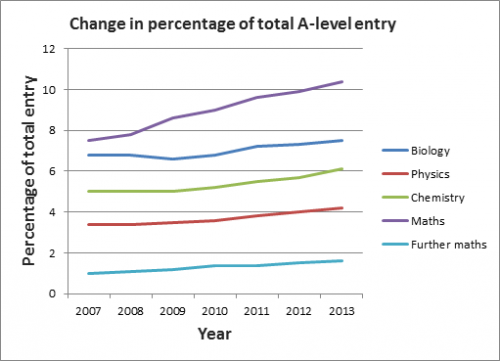
This graph shows that the proportion of all A-level entries accounted for by physics, maths and other sciences has been growing steadily in recent years. (Courtesy: CaSE)
By Matin Durrani
Getting more people interested in physics is something we hear about all the time here at Physics World.
When I was in India last year, for example, I lost count of the number of times physicists said there weren’t enough people going into the subject. Engineering and medicine seemed to be the top choices for technically minded Indian students going to university.
A worrying decline in interest in physics was a message I also heard while in Korea earlier this year.
So it was really pleasing to learn today that the number of school pupils choosing to sit A-levels in physics in England, Wales and Northern Ireland has risen for the seventh consecutive year. They have gone up from a low of 27,368 in 2006 to 35,569 this year.
A-levels are taken mostly by 18-year-olds – and top grades in the exam are vital for anyone wanting to get into the university of their choice.
In fact, numbers rose from 34,509 in 2012 to 35,569 this year, even though the overall cohort of students sitting A-level exams for all subjects is down by 2.5% on last year. And in breaking through the 35,000 barrier, the UK has also beaten a target that the government set itself – and done so a year earlier than planned.
The Institute of Physics, which publishes Physics World, said this achievement underlined the success of its government-funded Stimulating Physics Network (SPN), which provides support for schools in England teaching physics.
The only downer among the good news is that the fraction of girls taking A-level physics remains stubbornly low at just 20.6% of the total. “Anachronistic gender stereotypes persist in many classrooms,” IOP president Sir Peter Knight claims, “and these contribute to an outrageous unfairness that we continue to fight against.”
Whether all those students with A-level physics under their belts will actually go on to study the subject at university remains to be seen, of course.
But why are numbers on the up?
I see three main reasons, but there are probably more. One, for sure, is the search for the Higgs boson, which has really given physics a shot in the arm. Another is the contributions of popularizers like Brian Cox, who – like him or loathe him – is at least widely known and has brought physics to places it wouldn’t normally reach. And a third is certainly the (often unsung) efforts of organizations like the IOP.
But before anyone gets too carried away, one shouldn’t forget that back in the 1980s, the numbers taking A-level physics were regularly above the 45,000 mark. So while the situation is improving, physics still has a long way to go to reach the lofty position it used to occupy.
When one discusses with the school pupils, one finds that the main reason for the increased intertest in physics are the different aspects of cosmology such as the fossil CMB, the dark matter, the dark energy and the well-structured nature of the cosmos in terms of its galaxies. The finding of the Higgs-like boson was just a momentary impulse.
The Big Bang Theory TV show has greatly increased Physics “coolness factor.”
Trackback: Por más estudiantes que elijan Física | Para la clase de Física.
It would be interesting to know how many of the students taking the A levels in physics actually go into pure physics, as this blog apparently assumes. I guess many of them go into applied physics and engineering, which is also good.
The influence of internet may be also contributing, since science information is being transmitted very efficiently.
Regarding the fraction of girls, if it remains steady, it means their number is also rising in absolute terms, which isn’t bad at all.
P S: I really hope the reason of the increase has nothing to do with The Big Bang Theory. That would be a bad reason to make such a serious decision.
The ‘big’ issues in science have always been popularised within the broader culture. This is especially true of the media and the accessibility of information and communication.
There is also another factor. Many students have perceived Physics as especially ‘hard’, however, it’s not just the enthusiasm and deep interest in the subject that has driven the increase. It it also down to a growing understanding that employers value the ‘skills’ inherent in understanding the subject.
Given severe austerity in these recessionary hit times, students are beginning to realise that the so called ‘hard’ subjects are just those ones they need to master if they are to win out in the competition for jobs.